air conditioning CHEVROLET TRACKER 2002 2.G Owners Manual
[x] Cancel search | Manufacturer: CHEVROLET, Model Year: 2002, Model line: TRACKER, Model: CHEVROLET TRACKER 2002 2.GPages: 390, PDF Size: 2.62 MB
Page 146 of 390
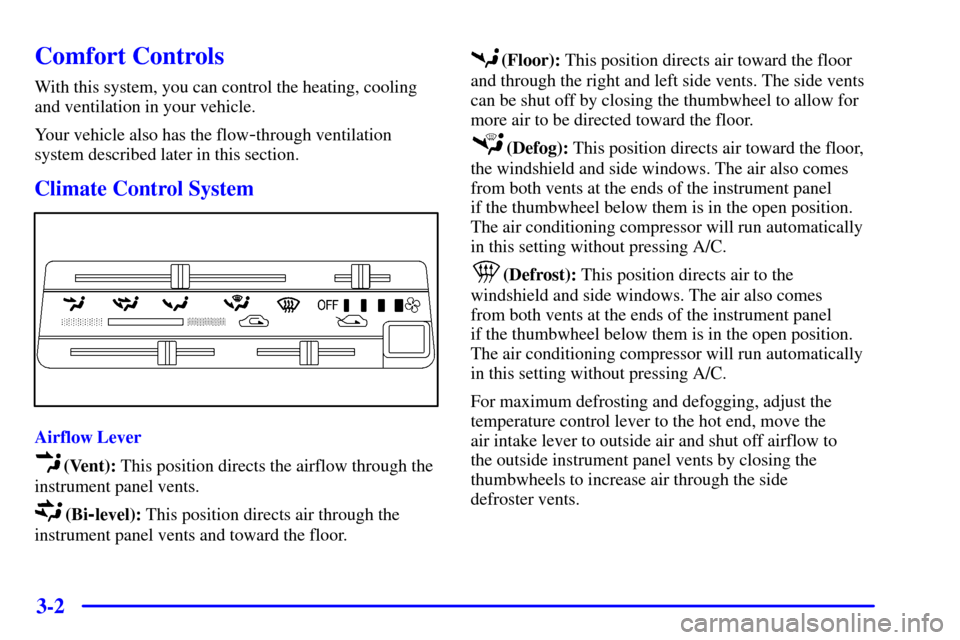
3-2
Comfort Controls
With this system, you can control the heating, cooling
and ventilation in your vehicle.
Your vehicle also has the flow
-through ventilation
system described later in this section.
Climate Control System
Airflow Lever
(Vent): This position directs the airflow through the
instrument panel vents.
(Bi-level): This position directs air through the
instrument panel vents and toward the floor.
(Floor): This position directs air toward the floor
and through the right and left side vents. The side vents
can be shut off by closing the thumbwheel to allow for
more air to be directed toward the floor.
(Defog): This position directs air toward the floor,
the windshield and side windows. The air also comes
from both vents at the ends of the instrument panel
if the thumbwheel below them is in the open position.
The air conditioning compressor will run automatically
in this setting without pressing A/C.
(Defrost): This position directs air to the
windshield and side windows. The air also comes
from both vents at the ends of the instrument panel
if the thumbwheel below them is in the open position.
The air conditioning compressor will run automatically
in this setting without pressing A/C.
For maximum defrosting and defogging, adjust the
temperature control lever to the hot end, move the
air intake lever to outside air and shut off airflow to
the outside instrument panel vents by closing the
thumbwheels to increase air through the side
defroster vents.
Page 147 of 390
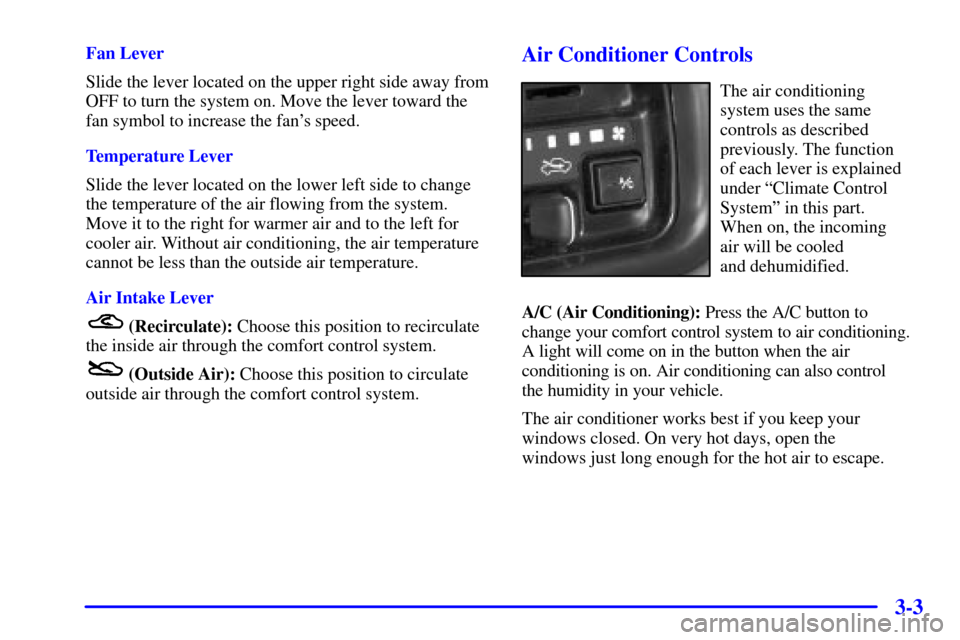
3-3
Fan Lever
Slide the lever located on the upper right side away from
OFF to turn the system on. Move the lever toward the
fan symbol to increase the fan's speed.
Temperature Lever
Slide the lever located on the lower left side to change
the temperature of the air flowing from the system.
Move it to the right for warmer air and to the left for
cooler air. Without air conditioning, the air temperature
cannot be less than the outside air temperature.
Air Intake Lever
(Recirculate): Choose this position to recirculate
the inside air through the comfort control system.
(Outside Air): Choose this position to circulate
outside air through the comfort control system.
Air Conditioner Controls
The air conditioning
system uses the same
controls as described
previously. The function
of each lever is explained
under ªClimate Control
Systemº in this part.
When on, the incoming
air will be cooled
and dehumidified.
A/C (Air Conditioning): Press the A/C button to
change your comfort control system to air conditioning.
A light will come on in the button when the air
conditioning is on. Air conditioning can also control
the humidity in your vehicle.
The air conditioner works best if you keep your
windows closed. On very hot days, open the
windows just long enough for the hot air to escape.
Page 148 of 390
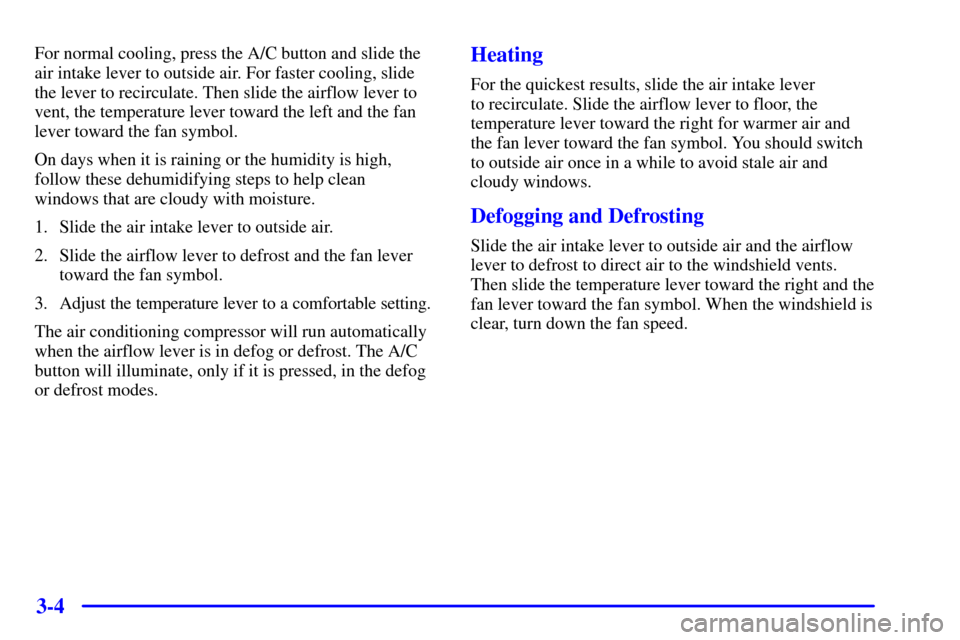
3-4
For normal cooling, press the A/C button and slide the
air intake lever to outside air. For faster cooling, slide
the lever to recirculate. Then slide the airflow lever to
vent, the temperature lever toward the left and the fan
lever toward the fan symbol.
On days when it is raining or the humidity is high,
follow these dehumidifying steps to help clean
windows that are cloudy with moisture.
1. Slide the air intake lever to outside air.
2. Slide the airflow lever to defrost and the fan lever
toward the fan symbol.
3. Adjust the temperature lever to a comfortable setting.
The air conditioning compressor will run automatically
when the airflow lever is in defog or defrost. The A/C
button will illuminate, only if it is pressed, in the defog
or defrost modes.Heating
For the quickest results, slide the air intake lever
to recirculate. Slide the airflow lever to floor, the
temperature lever toward the right for warmer air and
the fan lever toward the fan symbol. You should switch
to outside air once in a while to avoid stale air and
cloudy windows.
Defogging and Defrosting
Slide the air intake lever to outside air and the airflow
lever to defrost to direct air to the windshield vents.
Then slide the temperature lever toward the right and the
fan lever toward the fan symbol. When the windshield is
clear, turn down the fan speed.
Page 218 of 390
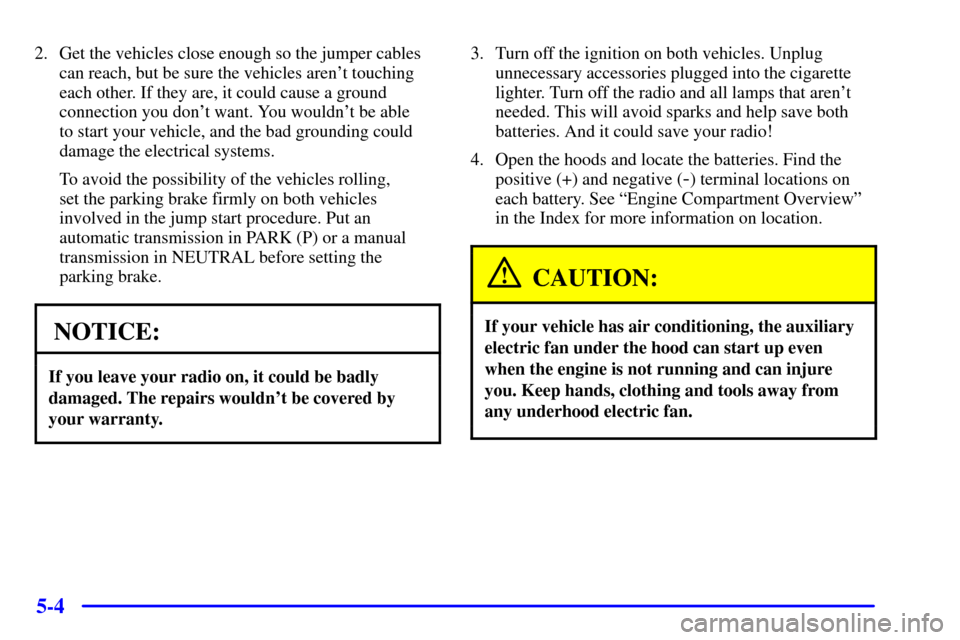
5-4
2. Get the vehicles close enough so the jumper cables
can reach, but be sure the vehicles aren't touching
each other. If they are, it could cause a ground
connection you don't want. You wouldn't be able
to start your vehicle, and the bad grounding could
damage the electrical systems.
To avoid the possibility of the vehicles rolling,
set the parking brake firmly on both vehicles
involved in the jump start procedure. Put an
automatic transmission in PARK (P) or a manual
transmission in NEUTRAL before setting the
parking brake.
NOTICE:
If you leave your radio on, it could be badly
damaged. The repairs wouldn't be covered by
your warranty.
3. Turn off the ignition on both vehicles. Unplug
unnecessary accessories plugged into the cigarette
lighter. Turn off the radio and all lamps that aren't
needed. This will avoid sparks and help save both
batteries. And it could save your radio!
4. Open the hoods and locate the batteries. Find the
positive (+) and negative (
-) terminal locations on
each battery. See ªEngine Compartment Overviewº
in the Index for more information on location.
CAUTION:
If your vehicle has air conditioning, the auxiliary
electric fan under the hood can start up even
when the engine is not running and can injure
you. Keep hands, clothing and tools away from
any underhood electric fan.
Page 316 of 390
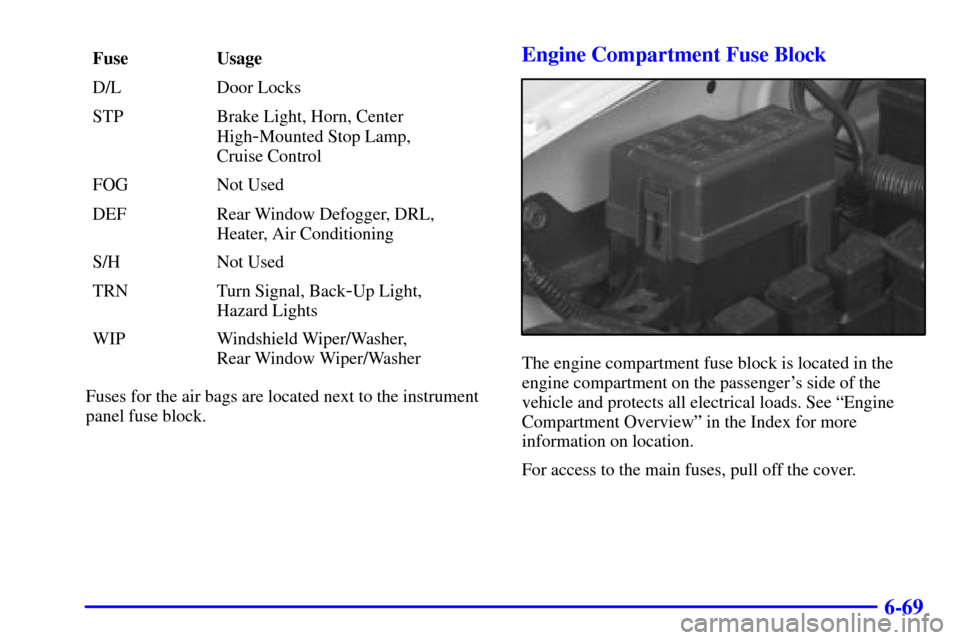
6-69
Fuse Usage
D/L Door Locks
STP Brake Light, Horn, Center
High
-Mounted Stop Lamp,
Cruise Control
FOG Not Used
DEF Rear Window Defogger, DRL,
Heater, Air Conditioning
S/H Not Used
TRN Turn Signal, Back
-Up Light,
Hazard Lights
WIP Windshield Wiper/Washer,
Rear Window Wiper/Washer
Fuses for the air bags are located next to the instrument
panel fuse block.
Engine Compartment Fuse Block
The engine compartment fuse block is located in the
engine compartment on the passenger's side of the
vehicle and protects all electrical loads. See ªEngine
Compartment Overviewº in the Index for more
information on location.
For access to the main fuses, pull off the cover.
Page 317 of 390
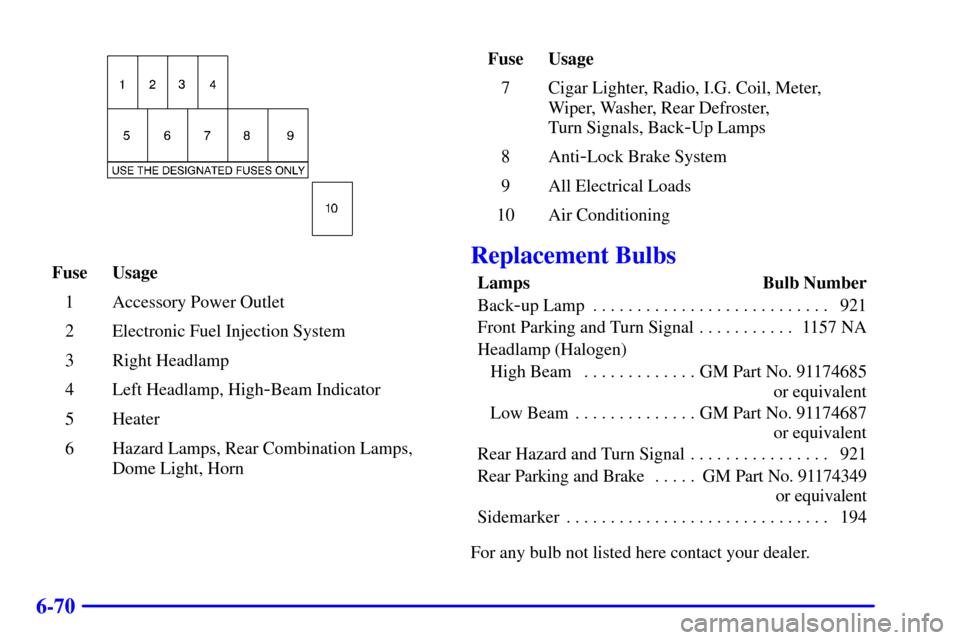
6-70
Fuse Usage
1 Accessory Power Outlet
2 Electronic Fuel Injection System
3 Right Headlamp
4 Left Headlamp, High
-Beam Indicator
5 Heater
6 Hazard Lamps, Rear Combination Lamps,
Dome Light, HornFuse Usage
7 Cigar Lighter, Radio, I.G. Coil, Meter,
Wiper, Washer, Rear Defroster,
Turn Signals, Back
-Up Lamps
8 Anti
-Lock Brake System
9 All Electrical Loads
10 Air Conditioning
Replacement Bulbs
Lamps Bulb Number
Back
-up Lamp 921. . . . . . . . . . . . . . . . . . . . . . . . . . .
Front Parking and Turn Signal 1157 NA. . . . . . . . . . .
Headlamp (Halogen)
High Beam GM Part No. 91174685. . . . . . . . . . . . .
or equivalent
Low Beam GM Part No. 91174687. . . . . . . . . . . . . .
or equivalent
Rear Hazard and Turn Signal 921. . . . . . . . . . . . . . . .
Rear Parking and Brake GM Part No. 91174349. . . . .
or equivalent
Sidemarker 194. . . . . . . . . . . . . . . . . . . . . . . . . . . . . .
For any bulb not listed here contact your dealer.
Page 319 of 390
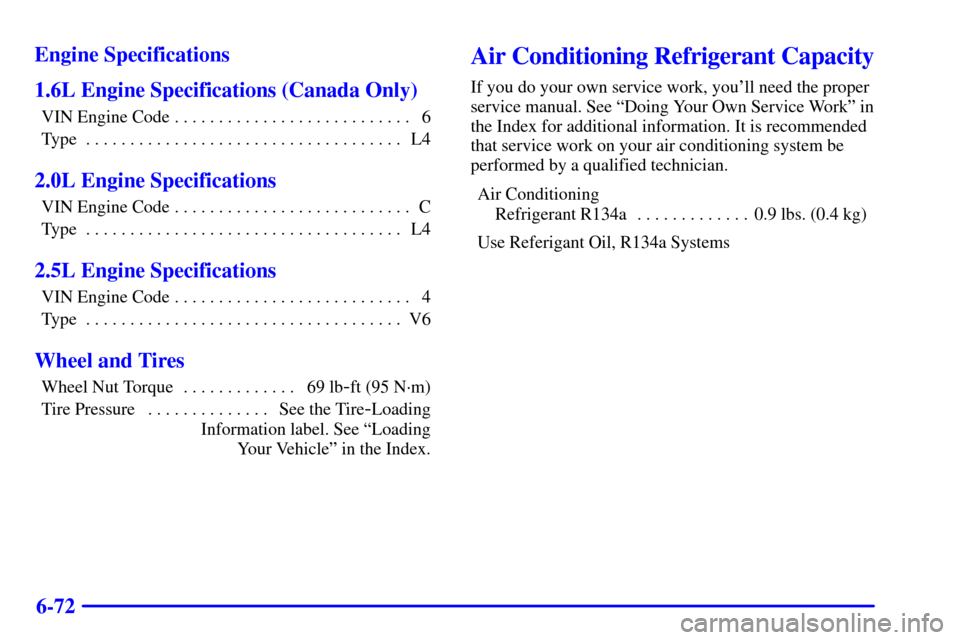
6-72 Engine Specifications
1.6L Engine Specifications (Canada Only)
VIN Engine Code 6. . . . . . . . . . . . . . . . . . . . . . . . . . .
Type L4. . . . . . . . . . . . . . . . . . . . . . . . . . . . . . . . . . . .
2.0L Engine Specifications
VIN Engine Code C. . . . . . . . . . . . . . . . . . . . . . . . . . .
Type L4. . . . . . . . . . . . . . . . . . . . . . . . . . . . . . . . . . . .
2.5L Engine Specifications
VIN Engine Code 4. . . . . . . . . . . . . . . . . . . . . . . . . . .
Type V6. . . . . . . . . . . . . . . . . . . . . . . . . . . . . . . . . . . .
Wheel and Tires
Wheel Nut Torque 69 lb-ft (95 N´m) . . . . . . . . . . . . .
Tire Pressure See the Tire
-Loading . . . . . . . . . . . . . .
Information label. See ªLoading
Your Vehicleº in the Index.
Air Conditioning Refrigerant Capacity
If you do your own service work, you'll need the proper
service manual. See ªDoing Your Own Service Workº in
the Index for additional information. It is recommended
that service work on your air conditioning system be
performed by a qualified technician.
Air Conditioning
Refrigerant R134a 0.9 lbs. (0.4 kg). . . . . . . . . . . . .
Use Referigant Oil, R134a Systems
Page 372 of 390
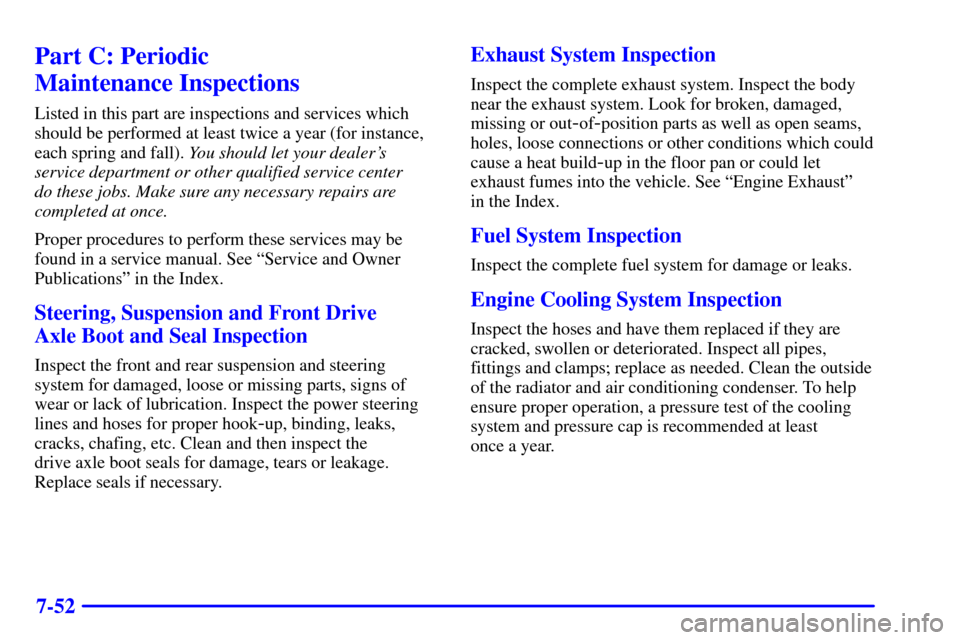
7-52
Part C: Periodic
Maintenance Inspections
Listed in this part are inspections and services which
should be performed at least twice a year (for instance,
each spring and fall). You should let your dealer's
service department or other qualified service center
do these jobs. Make sure any necessary repairs are
completed at once.
Proper procedures to perform these services may be
found in a service manual. See ªService and Owner
Publicationsº in the Index.
Steering, Suspension and Front Drive
Axle Boot and Seal Inspection
Inspect the front and rear suspension and steering
system for damaged, loose or missing parts, signs of
wear or lack of lubrication. Inspect the power steering
lines and hoses for proper hook
-up, binding, leaks,
cracks, chafing, etc. Clean and then inspect the
drive axle boot seals for damage, tears or leakage.
Replace seals if necessary.
Exhaust System Inspection
Inspect the complete exhaust system. Inspect the body
near the exhaust system. Look for broken, damaged,
missing or out
-of-position parts as well as open seams,
holes, loose connections or other conditions which could
cause a heat build
-up in the floor pan or could let
exhaust fumes into the vehicle. See ªEngine Exhaustº
in the Index.
Fuel System Inspection
Inspect the complete fuel system for damage or leaks.
Engine Cooling System Inspection
Inspect the hoses and have them replaced if they are
cracked, swollen or deteriorated. Inspect all pipes,
fittings and clamps; replace as needed. Clean the outside
of the radiator and air conditioning condenser. To help
ensure proper operation, a pressure test of the cooling
system and pressure cap is recommended at least
once a year.